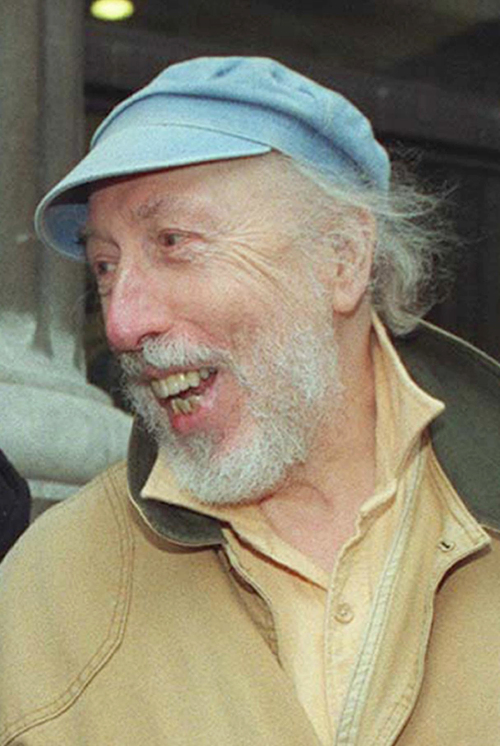LONDON (AFP) ― British pop art pioneer Richard Hamilton, whose work ranged from images of consumer culture to parodies of political leaders, died on Tuesday at the age of 89, the gallery that represented him said.
His seminal 1956 collage “Just What Is It That Makes Today’s Homes So Different, So Appealing?” featuring a bodybuilder and a tin of ham earned Hamilton the nickname “father of pop art.”
The artist also won worldwide recognition for designing the cover of the Beatles’ “White Album” and in recent years for his depiction of then British Prime Minister Tony Blair dressed as a cowboy.
His seminal 1956 collage “Just What Is It That Makes Today’s Homes So Different, So Appealing?” featuring a bodybuilder and a tin of ham earned Hamilton the nickname “father of pop art.”
The artist also won worldwide recognition for designing the cover of the Beatles’ “White Album” and in recent years for his depiction of then British Prime Minister Tony Blair dressed as a cowboy.

The Gagosian Gallery, a chain of galleries which represented Hamilton and had branches in several countries, said the art world had “lost one of its leading figures.”
Gallery owner Larry Gagosian added: “This is a very sad day for all of us and our thoughts are with Richard’s family, particularly his wife Rita and his son Rod.”
Hamilton is believed to have died after an illness, but the Gagosian did not give any more details about the cause or say where he died.
Up until a few days before his death, he was working on a major museum retrospective, which was due to travel to Los Angeles, Philadelphia, London and Madrid.
The artist was born in London in February 1922 and studied at the Royal Academy Schools and Slade School of Fine Art.
One of his best-known works was the plain white cover for the “White Album” of 1968.
It featured a white square with the name of the band and a grey number in the corner, a sharp contrast to the colorful cover of the preceding album, “Sgt Pepper’s Lonely Hearts Club Band,” designed by Peter Blake.
Hamilton’s design is notable as the only Beatles’ album cover not to depict the band’s members.
Another famous work is his 1968-69 painting “Swingeing London,” showing Rolling Stones frontman Mick Jagger hiding his face in the back of a police car following a police drugs raid.
In his later years, he became as famous for his political images as for his works parodying consumerism.
His 2007-2008 work “Shock and Awe,” named after the massive aerial assault launched on Baghdad in 2003 at the start of the U.S.-led invasion, featured Blair wearing a cowboy shirt, with guns and holsters.
Hamilton said he produced the image after he saw Blair looking smug after a conference with then U.S. president George W. Bush.
Asked not long before his death about the “father of pop art” label, Hamilton said it was not a term he attached himself to.
“While I was interested in the pop phenomenon, I never associated myself with the term, which I used to describe Elvis Presley and rather vulgar American imagery of ice cream cones or hamburgers,” he said.
The Gagosian said that the artist’s “fascination with the authenticity of the image in contemporary society, and the implication this has in political and moral terms, has held him at the vanguard of modern art.
“His influence on subsequent generations of artists continues to be immeasurable.”
Nicholas Serota, director of the Tate gallery in London, added Hamilton died as he would have wished, working right up to the end.
Hamilton “was one of the most influential and distinctive artists of the post war period,” said Serota.
“Greatly admired by his peers, including Warhol and Beuys, Hamilton produced a series of exquisite paintings, drawings, prints ... dealing with themes of glamour, consumption, commodity and popular culture.”


![[Exclusive] Korean military set to ban iPhones over 'security' concerns](http://res.heraldm.com/phpwas/restmb_idxmake.php?idx=644&simg=/content/image/2024/04/23/20240423050599_0.jpg&u=20240423183955)

![[Graphic News] 77% of young Koreans still financially dependent](http://res.heraldm.com/phpwas/restmb_idxmake.php?idx=644&simg=/content/image/2024/04/22/20240422050762_0.gif&u=)



![[Pressure points] Leggings in public: Fashion statement or social faux pas?](http://res.heraldm.com/phpwas/restmb_idxmake.php?idx=644&simg=/content/image/2024/04/23/20240423050669_0.jpg&u=)









